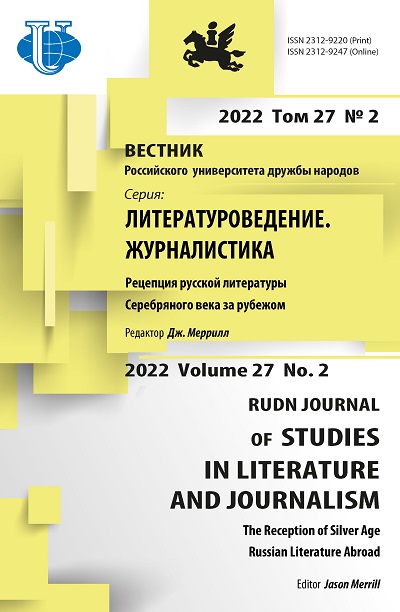Американская корпорация Union Carbide и катастрофа в Бхопале: PR до и после инцидента
- Авторы: Патель К.1, Бинжола Х.2
-
Учреждения:
- Национальный открытый университет Индиры Ганди
- Университет График Эра Хилл
- Выпуск: Том 27, № 2 (2022): РЕЦЕПЦИЯ РУССКОЙ ЛИТЕРАТУРЫ СЕРЕБРЯНОГО ВЕКА ЗА РУБЕЖОМ
- Страницы: 436-446
- Раздел: Журналистика
- URL: https://journals.rudn.ru/literary-criticism/article/view/31468
- DOI: https://doi.org/10.22363/2312-9220-2022-27-2-436-446
- ID: 31468
Цитировать
Полный текст
Аннотация
Сделана попытка понять катастрофу в Бхопале (также известную как Бхопальская газовая трагедия) в контексте связей с общественностью, выявить роль, которую корпорация Union Carbide Corporation сыграла в событиях, когда погибло более 3000 человек, а 15 000 индийцев получили смертельные увечья. Этот случай потряс всю страну, раньше никто представить себе не мог, что промышленная авария может иметь такие последствия, привести к отравлению тысяч людей. Авторы анализируют инцидент с точки зрения антикризисного PR, выявляют действия Union Carbide в период до и после событий. Авторы пытаются ответить на вопрос о том, каким образом корпорация Union Carbide смогла бы сохранить и улучшить международный имидж, ответственно используя технологии связей с общественностью в Индии, следуя политике социальной ответственности. Бхопальская газовая трагедия стала важным событием для понимания кризисных ситуаций и изучения возможностей PR в управлении коммуникациями. Этот случай стал своего рода притчей во языцех: национальная трагедия спровоцировала обсуждение проблемной ситуации в отношениях руководителей и подчиненных, когда оптимизация взаимодействия была необходима, но не задействована.
Об авторах
Кешав Патель
Национальный открытый университет Индиры Ганди
Email: keyshavpatel@gmail.com
ORCID iD: 0000-0001-9072-291X
академический советник
Индия, 110068, Нью-Дели, Майдан ГархиХимани Бинжола
Университет График Эра Хилл
Автор, ответственный за переписку.
Email: binjola.himani@gmail.com
ORCID iD: 0000-0002-6903-7632
доцент кафедры средств массовой информации и массовых коммуникаций
Индия, 248002, Уттаракханд, Дехрадун, Клемент Таун, Общественная зона, Белл-роуд, 566/6Список литературы
- Abraham, M. (1984). The Lessons of Bhopal: A Community Action Resource Manual on Hazardous Technologies. Penang, Malaysia: International Organization of Consumers Unions, Regional Office for Asia and the Pacific
- Agarwal, A. (2019). 35 years of Bhopal Gas Tragedy: Anil Agarwal on what happened that fateful night. Retrieved from https://www.downtoearth.org.in/news/environment/35years-of-bhopal-gas-tragedy-anil-agarwal-on-what-happened-that-fateful-night-68232
- Banerjee, B.N. (1986). Bhopal gas tragedy: accident or experiment. New Delhi: Paribus Publishers and Distributors.
- Bergman, D. (1988). The sabotage theory and the legal strategy of Union Carbide. New Law Journal, 138.
- Bhopal, industrial genocide?: a unique compilation of documents from Indian publications. (1985). Hong kong: ARENA Press.
- Bowonder, B. (1987). An analysis of the Bhopal accident. Project Appraisal, 2(3), 157-168. https://doi.org/10.1080/02688867.1987.9726622
- Broughton, E. (2005). The Bhopal disaster and its aftermath: a review. Environmental health, 4(6). https://doi.org/10.1186/1476-069X-4-6
- Chatterjee, P. (2012). WikiLeaks’ Stratfor dump lifts lid on intelligence-industrial complex. Retrieved from https://www.theguardian.com/
- Diamond, S. (1985). The Bhopal Disaster: How it happened. Retrieved from https://www.nytimes.com/
- Eckerman, I. (2004). The Bhopal Saga - Causes and Consequences of the World’s Largest Industrial Disaster. Bhopal, Madhya Pradesh, India: Universities Press. https:// doi.org/10.13140/2.1.3457.5364
- Edwards, T. (2014). Criminal Failure and “The Chilling Effect”: A Short History of the Bhopal Criminal Prosecutions. Social Justice, 41(1/2), 53-79.
- Fortun, K. (2001). Advocacy alter Bhopal: Environmentalism, Disaster, New Global Orders. Chicago, London: The University of Chicago Press. ICJB. (n.d.). 1969-1979: Union Carbide Enters Bhopal. Retrieved from https://www.bhopal.net/
- Amnesty International. (2004). Clouds of Injustice: Bhopal Disaster 20 Years On. Amnesty International Publ.
- Lewis, S. (2007). The Bhopal Chemical Disaster: Twenty Years Without Justice. Retrieved from https://archive.org/details/SanfordLewisTwentyYearsWithoutJusticeTheBhopalChemicalDisaster
- Narain, S., Bhushan, C. (2014). 30 years of Bhopal gas tragedy: a continuing disaster. Retrieved from https://www.downtoearth.org.in/coverage/environment/30-years-of-bhopal-gas-tragedy-a-continuing-disaster-47634
- Sachdeva, I. (2009). Public Relations: Principles and Practices. Oxford Higher Education.
- Sahabat Alam Malaysia (SAM) & Asia-Pacific’s People’s Environment Network (APPEN). (1986). The Bhopal Tragedy - One Year After. Penang, Malaysia: SAM.
- Tombs, F.P. (2011). Flowers at the altar of profit and power: The continuing disaster at Bhopal. Retrieved from https://www.crimetalk.org.uk/
Дополнительные файлы















